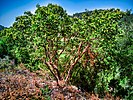Biology:Arbutus andrachne
| Arbutus andrachne | |
|---|---|

| |
| Tree of Arbutus andrachne at Orto Botanico dell'Università di Genova | |
| Scientific classification | |
| Kingdom: | Plantae |
| Clade: | Tracheophytes |
| Clade: | Angiosperms |
| Clade: | Eudicots |
| Clade: | Asterids |
| Order: | Ericales |
| Family: | Ericaceae |
| Genus: | Arbutus |
| Species: | A. andrachne
|
| Binomial name | |
| Arbutus andrachne | |
| Synonyms[2] | |
| |
Arbutus andrachne, commonly called the Greek strawberry tree, is an evergreen shrub or small tree in the family Ericaceae, native to the Mediterranean region and the Middle East.
The etymology of the species name corresponds to the Ancient Greek word ἀνδράχνη (andrákhnē), meaning "wild strawberry",[3][4] and refers to the common name of the tree and to its fruits.
Description
Arbutus andrachne can reach a height of about 12 metres. The smooth bark is exfoliating during the summer, leaving a layer with a pistachio green colour, which changes gradually to a beautiful orange brown. The flowers bloom in spring and are white or yellowish green. Its fruits ripen in autumn, and when left to dry in a cool place, are eaten as sweet, chewy candy.
According to a research study done by Alzoubi, the A. andrachne fruit's antioxidants contain a variety of chemicals that have a defensive effect against memory impairment where the antioxidants normalize the long- and short-term memory impairment caused from sleep deprivation.[5][6]
Horticulture
Hybrids
- Arbutus x andrachnoides Link, 1821 is a hybrid between A. andrachne and A. unedo.[7][8]
- Arbutus x thuretiana Demoly, nothosp. nov. is a hybrid between A. andrachne and A. canariensis.[7] Named after Gustave Thuret, it is naturalised at Jardin botanique de la Villa Thuret.[9] A. x thuretiana is renowned for its perfectly smooth, reddish-brown bark, exfoliating in the spring to show a new, surprisingly pistachio-green bark, which gradually darkens and turns reddish again.[7]
Garden history
Arbutus andrachne was reported by Peter Collinson as having flowered first in England in Dr John Fothergill's extensive botanical garden and greenhouses at Upton House, Essex (now West Ham Park), in 1765.[10]
In literature
"On leaving Bursa ... There was on the road a small tree bearing a fruit somewhat bigger than our largest cherries, and of the shape and taste of strawberries, but a little acid. It is pleasant to eat; but, if a great quantity be eaten, it mounts to the head, and intoxicates. It is ripe in November and December." Editor's footnote: "From the description, it seems to be the arbutus Andrachne."[11] The tree appears to exist in Dibbeen Forest Reserve in Jordan with its distinctive reddish bark that appears more red during and immediately after rain. Locals confirm that the fruits have narcotic-like effect.[citation needed] The fruits are reddish and sweet but taste more like figs.[citation needed]
Gallery
The hybrid Arbutus x andrachnoides
References
- ↑ Species was first described and published in Systema Naturae, ed. 10. 2: 1024. 1759. "Plant Name Details for Arbutus andrachne". IPNI. http://www.ipni.org:80/ipni/idPlantNameSearch.do?id=326280-2. "in monte Pentelico Atticae"
- ↑ "The Plant List: A Working List of All Plant Species". http://www.theplantlist.org/tpl1.1/record/kew-2646651.
- ↑ Bailly, Anatole (1981-01-01). Abrégé du dictionnaire grec français. Paris: Hachette. ISBN 978-2010035289. OCLC 461974285.
- ↑ Bailly, Anatole. "Greek-french dictionary online". http://www.tabularium.be/bailly/.
- ↑ Alzoubi, Karem H.; Malkawi, Bayan S.; Khabour, Omar F.; El-Elimat, Tamam; Alali, Feras Q. (2017-01-18). "Arbutus andrachne L. Reverses Sleep Deprivation-Induced Memory Impairments in Rats". Molecular Neurobiology 55 (2): 1150–1156. doi:10.1007/s12035-017-0387-8. PMID 28101814.
- ↑ Bertsouklis, Konstantinos F.; Daskalakis, Ioannis; Biniari, Katerina; Papafotiou, Maria (2021-02-15). "Comparative study of polyphenolic content and antioxidant capacity in fruits of Arbutus unedo, A. andrachne and their natural hybrid A.× andrachnoides" (in en). Notulae Botanicae Horti Agrobotanici Cluj-Napoca 49 (1): 12165. doi:10.15835/nbha49112165. ISSN 1842-4309. https://www.notulaebotanicae.ro/index.php/nbha/article/view/12165.
- ↑ 7.0 7.1 7.2 Filippi, Olivier (2007) (in fr). Pour un jardin sans arrosage (For a garden without irrigation). Arles: Actes Sud. p. 80. ISBN 978-2-7427-6730-4.
- ↑ Bertsouklis, Konstantinos Fotios; Papafotiou, Maria (2016-12-14). "Morphometric and Molecular Analysis of the Three Arbutus Species of Greece" (in en). Notulae Botanicae Horti Agrobotanici Cluj-Napoca 44 (2): 423–430. doi:10.15835/nbha44210572. ISSN 1842-4309. https://www.notulaebotanicae.ro/index.php/nbha/article/view/10572.
- ↑ Ducatillon, Catherine; Bellanger, Richard; Charron, Tristan; Chevallier, Joelle; Heinz, Christine; Marchal, Cecilia; Mellerin, Yannick; Caraglio, Yves et al. (2018), "Study of the adaptability of trees to drought:phenological monitoring of assisted growth sensors, in the Botanical Garden of Villa Thuret", Proceedings of the EuroGard VII Congress (EUROGARD) VII: pp. 322–331, https://hal.archives-ouvertes.fr/hal-01839201, retrieved 2020-03-23
- ↑ Ann Leighton, American Gardens in the Eighteenth Century: 'For Use or Delight' , 1976:395; Leighton misidentifies it with Arbutus unedo; Georg Dionysius Ehret, "A description of the Andrachne" Philosophical Transactions of the Royal Society 57 (1767)
- ↑ Thomas Wright, ed (1848). "The travels of Bertrandon de la Brocquière". Early Travels in Palestine, comprising the narratives of Arculf, Willibald, Bernard, Saewulf, Sigurd, Benjamin of Tudela, de la Brocquière, Sir John Maundeville and Maundrel. p. 333. https://books.google.com/books?id=OrsMAAAAIAAJ.
Wikidata ☰ Q938579 entry
 |








